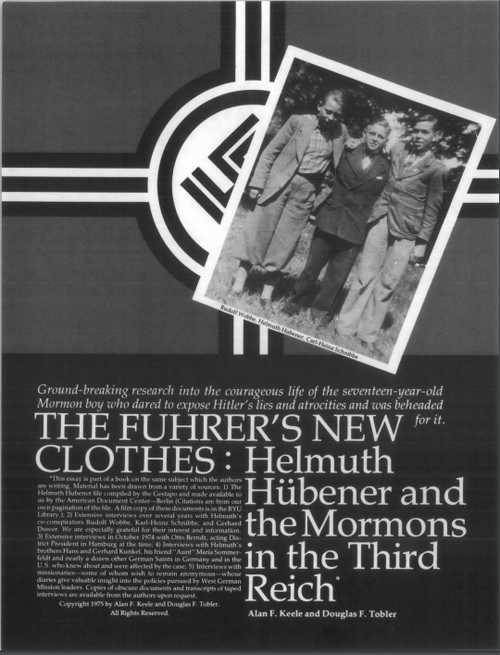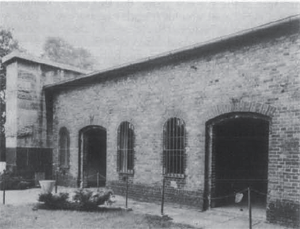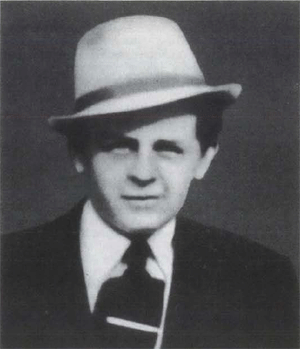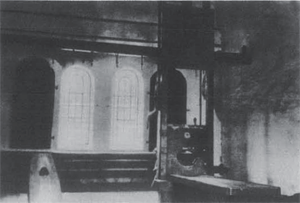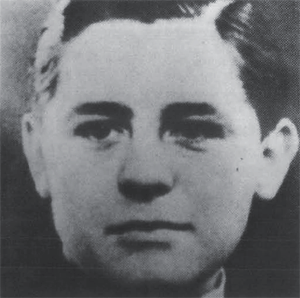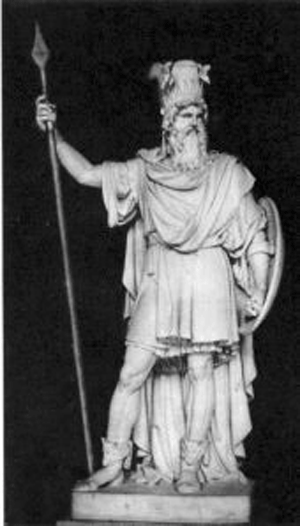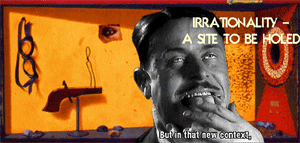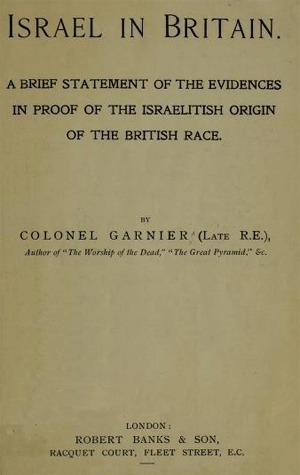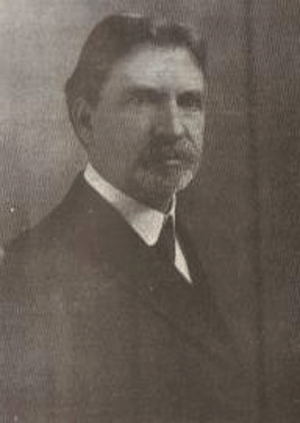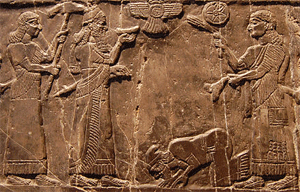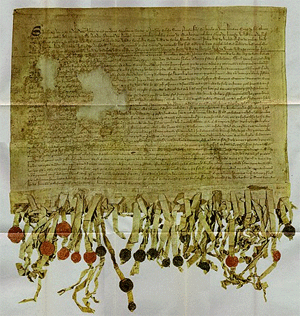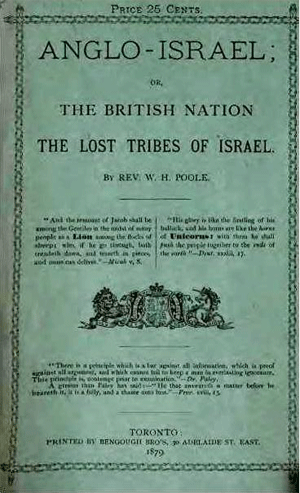Part 3 of 3
_______________
Notes: 1. Ernst Christian Helmreich, The German Churches Under Hitler: Background, Struggle, and Epilogue (Detroit: Wayne State University Press, 1979), pp. 128- 132.
2. The Nazis controlled Germany through their policy of Gleichschaltung or coordination/regimentation to Party aims.
3. Christine Elizabeth King, "Strategies for Survival: An Examination of the History of Five Christian Sects in Germany 1933-45," Journal of Contemporary History 14 (1979), 211; Christine Elizabeth King, The Nazi State and the New Religions (Lewiston, NY: The Edwin Mellen Press, 1982), p. 20.
4. Usually the small, non-traditional religions in Germany are referred to as "sects," which carries a pejorative connotation in German.
5. King, The Nazi State and the New Religions, pp. 19-20; King, "Strategies for Survival," 211. King argues that such considerations were based on the denomination's use as a propaganda tool, its wealth and influence and the amount of trouble that would be caused abroad if the denomination were persecuted.
6. See Table 10 in Jeffrey L. Anderson, "Mormons and Germany, 1914-1933: A History of the Church of Jesus Christ of Latter-day Saints in Germany and its Relationship with the German Governments from World War I to the Rise of Hitler" (M.A. Thesis, Brigham Young University, Provo, Utah, 1991), pp. 214- 215.
7. Douglas F. Tobler and Alan F. Keele, "The Saints and the Reich: German Mormons under Hitler" (unpublished essay), pp. 3-4. Copy in author's possession.
8. Douglas F. Tobler, "The Narrow Line: The Experiences of the American Mormon Missionaries in Hitler's Germany, 1933-1939" (unpublished essay), p. 12. Copy in author's possession.
9. For the text of the respective responses to the Gestapo, see Oliver Budge letter to State Secret Police office, 8 September 1933, in "German- Austrian Mission Quarterly Reports, 1930-1937," Archives, Historical Department of the Church of Jesus Christ of Latter-day Saints, Salt Lake City, Utah, entry for "Visit of Secret Service Agent, (hereafter cited as "German-Austrian Quarterly Reports)," and "Ein Aufklarender Brief," Der Stern, 65 (15 July 1933), 214-218. See full text in Appendix A and Appendix B.
10. Tobler and Keele, "The Saints and the Reich," p. 8.
11. Or in other words whatever regime was in power at the time. Pearl of Great Price, Article of Faith 1:12. "We believe in being subject to kings, presidents, rulers, and magistrates, in obeying, honoring, and sustaining the law."
12. Pearl of Great Price, Article of Faith 1:11. "We claim the privilege of worshiping Almighty God according to the dictates of our own conscience, and allow all men the same privilege, let them worship how, where, or what they may."
13. John A. Dahl, "Book Review of Building Zion," typed manuscript, Archive MS 15335, unpublished manuscript dated 14 October 1997, Archives, Historical Department of the Church of Jesus Christ of Latter-day Saints, Salt Lake City, Utah, comment #16, pp. 10-11. Dahl states that "Rudolph Noss ... President of the Frankfurt am Main LDS district ... after clearing with Francis Salzner armed with a briefcase full of all the pamphlets and the Standard Works then used in Germany met with the proper office of the Department of Culture and Education in Darmstadt, Hessen-Darmstadt. He invited them to study this material containing the principles of the gospel which our Elders were teaching freely to those interested in their message; and also to convince them that members of the Church of Jesus Christ of Latter-day Saints were admonished to be law-abiding citizens. He further pointed out that these American Elders would bring in sorely needed US dollars." (Italics added)
14. See Appendix A and B.
15. Tobler and Keele, "The Saints and the Reich," pp. 6-7.
16. Fay Ollorton, "A Visit to the German -Austrian Mission," Deseret News, 2 1 October 1933, Church Section, p. 3.
17. Eric A. Johnson, Nazi Terror: The Gestapo, Jews, and Ordinary Germans (New York: Basic Books, 1999), p. 229; John S. Conway, The Nazi Persecution of the Churches, 1933-1945 (New York: Basic Books, Inc., Publishers, 1968), p. 69.
18. Many German Mormons have discussed visits to church meetings by the Gestapo. See, for example, Karl-Heinz Schnibbe, Oral History, Interview by Steve Carter, 2 May 1998, Holladay, Utah, Tape Recording/Typescript, 1, Copy in author's possession; Inge Lang, Oral History, Interview by Steve Carter, 28 June 1998, Bountiful, Utah, Tape Recording, Copy in author's possession; Dahl, "Book Review," comment, #14, pp. 9-10; John A. Dahl, Oral History, Interview by Steve Carter, 21 March 2000, Salt Lake City, Utah, Tape Re cording/Typescript, p. 18, Copy in author's possession; Walter H. Speidel, Oral History, Interview by Steve Carter, Tape recording/Typescript, Provo, Utah, 30 April 1998, p. 7, Copy in author's possession.
Gestapo monitoring of Mormon meetings varied from place to place. Usually, a plain-clothed agent slipped in and sat quietly in the back of the church. Occasionally, he might solicit information about upcoming "sermons." In these cases, the branch president provided the agent with a list of scheduled speakers for the next couple of weeks. In some branches, Gestapo agents attended meetings on a regular basis, and a few showed some congeniality with Church members. In other areas, there were few Gestapo visits. One German branch president recalled only one encounter with the Gestapo and that the agent left satisfied with what he found. 19. Both the Swiss-German Mission Manuscript History and German-Austrian Mission Manuscript History detail incidents where Gestapo agents interrogated missionaries and branch presidents as well as confiscated branch records. Agents usually seized the documents, examined them for a space of several weeks and returned them without explanation to the local LDS leader. See "German-Austrian Mission Manuscript History," Archives, Historical Department of the Church of Jesus Christ of Latter-day Saints, Salt Lake City, Utah. Hereafter cited as "German-Austrian MSS History." See also "Swiss-German Mission Manuscript History, 1904-1938," Archives, Historical Department of the Church of Jesus Christ of Latter-day Saints, Salt Lake City, Utah. Hereafter cited as "Swiss-German MSS History."
20. For instance, see "German-Austrian MSS History," entry for September 1934. German-Austrian mission records state: "The president of the Zwickau District was requested by the police in Plauen to furnish them with a list of the members of his district, and to inform them as to the party membership of each political party." (Italics added)
21. Tobler and Keele, "The Saints and the Reich," p. 15.
22. Speidel, Oral Interview, 30 April 1998, p. 2; Walter H. Speidel, Oral History, Interview by Steve Carter, Tape recording/Typescript, Provo, Utah, 1 May 1998, p. 7.
23. "Swiss-German MSS History" entry for January 1934. "The Police in Germany investigated our case in many branches but apparently did not come to any conclusions about us as no further steps were taken to stop out missionary activity."
24. One of Hitler's goals was to indoctrinate German youth in Nazi values which meant control of education and youth organizations.
25. In Germany, the Boy Scouts had grown rapidly after its founding in 1911, and by 1914, it numbered over 80,000 members. Scouting attracted many German Mormon youths in part because of the Church's sponsorship of the organization in the United States. In 1911, the LDS Church endorsed Scouting in the US and shortly thereafter adopted it in Germany. Mormon authorities in Europe believed the Boy Scouts could strengthen the LDS youth and bring others into contact with their religion.
By the 1930s, the Mormon Church had become a primary sponsor of the German Scout Association. By the end of 1933, the regime had eliminated all Scouting organizations except the two affiliated with the Mormon missions in Germany. At the time, according to mission records, there were 33 local Scout troops in the Swiss-German Mission alone. The German-Austrian Mission reported that over 150 teen-aged boys were registered in Scouts in that mission with another 100 youth who were involved in Scouting activities but were not registered. See Lawrence D. Walker, Hitler Youth and Catholic Youth, 1933-1936: A Study in Totalitarian Conquest, (Washington D.C.: The Catholic University of America Press, 1970), p. 8; "The Story of Scouting in the LDS Church," comp. LDS Relationships Boy Scouts of America,
http://gemstate.net/scouter/story.htm (28 September 2000); Tobler, "The Narrow Line," p. 15; "German-Austrian Quarterly Report," entry for 30 June 1934; "Swiss-German MSS History," entry for May, 1934; "German-Austrian Quarterly Report," entry for 30 June 1934.
26. "German-Austrian Quarterly Report," entry for 30 June 1934. The German-Austrian Quarterly Report contains copies of the letter exchange of March and April, 1934.
27. "German-Austrian MSS History," entry for 30 March 1934. The Scout troops from Weimar and Erfurt held a four-day outing. This is the last recorded Scouting activity in Germany before the program was dissolved.
28. "Swiss-German MSS History," entry for May 1934; "German-Austrian Quarterly Report," entry for 30 June 1934.
29.
Although the LDS regretted the end of the Scouting program, many Mormon youngsters joined the Hitler Youth. Some became active participants in the Nazi organization and fondly recalled the experience. Other boys either did not participate or, under pressure, merely went through the motions. Of the latter, many found it difficult to attend Sunday church meetings; still others reported renewed harassment by the Hitler Youth. Mormon girls, too, joined the BDM (Bund Deutsche Model), the female counterpart to the Hitler Youth. And, as with the boys, they had mixed reactions to it. Some were active participants, others were not. See Tobler and Keele, "The Saints and the Reich," p. 13; Fred Gassner and Erich Bernhardt, Oral History, Interview by Justus Ernst, 8 June 1985, transcript, Archives, Historical Department of the Church of Jesus Christ of Latter-day Saints, Salt Lake City, Utah, 26; Rudi Wobbe and Jerry Borrowman, Before the Blood Tribunal (Salt Lake City, UT: Covenant Communications, Inc., 1992), pp. 7-8.
30. "Chonik der Gemeinde Karlsruhe," comp. Karl Lutz, (Karlsruhe, Germany: Gemeinde Karlsruhe, Kirche Jesu Christi der Heiligen der Letzten Tage, 1997), p. 92. See also Doris L. Bergen, Twisted Cross: The German Christian Movement in the Third Reich (Chapel Hill, NC: The University of North Carolina Press, 1996), pp. 165-171, on the German Christians and Jewish expressions in church hymns.
31. Both mission presidents instructed members to avoid such terms in talks and to omit them from church hymns. See Dahl, Oral Interview, pp. 4-5 and Speidel, Oral Interview, 30 April 1998, p. 4.
32. "German-Austrian MSS History," entry 1 1 July 1936; Gilbert W. Scharffs, Mormonism in Germany: A History of the Church of Jesus Christ of Latter-day Saints in Germany (Salt Lake City, UT: Deseret Book Company, 1970), p. 85.
33. Kriminalpolizei Blatt no. 1751/54, in "Swiss-German MSS History," entry for January 1934. See also, "German-Austrian MSS History," entry for 5, 25 and 29 January 1934. During the first week of January 1934 the police forbid any further distribution of "Gottliche Vollmacht" in Germany. In both missions, the mission presidents complied with the order and had all copies of the tract either sent to the respective mission offices, turned over to the government officials or destroyed.
34. In the mid-1930s, for example, the regime banned the Christian Scientists from sending proceeds from the sale of their literature to the United States. Correspondence between the Christian Science Church and the United Stated diplomatic corps covering the period of 16 July 1936 to 28 July 1937, U. S. State Department Documents, 362. 116. Christian Science Church/8-12, National Archives, College Park, Maryland.
35. "Swiss-German MSS History," entry for September 1934.
36. The previous month, Finance Minister, Hjalmar Schacht, had launched a new economic policy that sought to impose "strict controls on the allocation of foreign exchange" for the purpose of building up currency reserves. See Ian Kershaw, Hitler 1889-1936: Hubris (New York: W. W. Norton & Company, 1999), p. 576.
37. Registered Marks were more valuable than regular Marks and used for international trade. Mormon missionaries had had the privilege of purchasing Registered Marks since the Weimar era. See also "German-Austrian Quarterly Reports," December 1934, entry for October.
38. "Swiss-German MSS History," entry for October 1934; "German-Austrian MSS History," entry for 6 October 1934; Tobler, "The Narrow Line," p. 17. The exchange rate for the Registered Mark was 3.31 per dollar, and for the regular Mark it was 2.48. According to Tobler, "the resulting loss of over 30% of the purchasing power of their $25 monthly check was difficult, if not devastating."
39. On 1 August 1934, Roy Welker replaced Oliver Budge as president of the East German Mission.
40. Correspondence between the LDS First Presidency and the United States diplomatic corps covering the period of 3 April to 13 April 1935, U. S. State Department Documents, 362.1 16.M82/35, 36, National Archives; Correspondence between William E. Dodd and Secretary of State, Corded Hull, and correspondence between U.S. State Department and LDS First Presidency covering a period between 28 May to 21 June 1935, U. S. State Department Documents, 362.1 16.M82/38, National Archives; "Swiss-German MSS History," entry for July 1935. See also Tobler, "Narrow Line," p. 17. The Benevolent Mark was an exchange rate which allowed missionaries to exchange fifty percent of their foreign currency for Registered Marks and fifty percent for Free Marks. "Swiss-German MSS History," entry for March 1936; "German-Austrian MSS History," entry under "During the month of March." According to records, missionaries would have to apply for the privilege of buying Registered Marks. They received an exchange rate of about RM 4 per $1. They could purchase up to 200 Registered Marks per month.
41. "Chronik der Gemeinde Karlsruhe," pp. 92-93.
President Salzner and his co-worker had a conversation with two officials of the State Police. He reported: 'The NS officials inquired about our work for the Church and requested that we should go to their office the next day for a discussion. I and my co-worker came as requested, were treaty politely and thoroughly questioned. The officials had a pile of newspaper and magazine articles about the Church to which they often referred during the conversation. After we were there an hour, they requested that we write a short history of the Church and describe the organization, goals and dimensions of our work. We complied with the request and presented the document on the following day. The officials informed us they were satisfied and assured us that we had no reason to fear. (Author's translation.)
42. William E. Dodd, Ambassador Dodd's Diary: 1933-1938, ed. by William E. Dodd, Jr., and Martha Dodd (New York: Harcourt, Brace and Company, 1941), p. 136.
43. King, The Nazi State and the New Religions, chapter 3. See also King "Strategies for Survival," pp. 225-228.
44. Tobler, "The Narrow Line," pp. 2-3.
45. "German-Austrian MSS History," entry for Thursday, 8 August 1935.
46. Tobler, "The Narrow Line," p. 3.
47. Helmreich, p. 405.
48. Ibid., p. 370 and 372.
49. Tobler and Keele, "The Saints and the Reich," p. 14.
50. Anderson, p. 157.
51. Tobler and Keele, "The Saints and the Reich," p. 14.
52. Joseph M. Dixon, "Mormons in the Third Reich: 1933-1945," Dialogue: A journal of Mormon Thought 7 (Spring 1972), 74. Dixon, argues that no "connection existed between the two ... but any parallels ... resulted from circumstance rather than plan."
53. For a thorough analysis of doctrinal common ground, see William D. Underwood, "Religions are Ordained of God: The Mormon Church in Nazi Germany" (M.A. Thesis, University of Cincinnati, Cincinnati, Ohio, 1992), pp. 40-48.
54. Anderson, pp. 154-155.
55. Tobler, "The Narrow Line," pp. 2-3.
56. Roy A. Welker, Oral History, interviewed by Richard Jensen, 2-3 February, 1973, Archives, Historical Department of The Church of Jesus Christ of Latter-day Saints, Salt Lake City, Utah, pp. 28-29.
57. Tobler and Keele, "The Saints and the Reich," pp. 13-14. Grant, more than likely, gave similar instructions to others who served as mission presidents during this period.
58. Ibid., p. 15.
59. Welker, Oral History, p. 31.
60. Scharffs, pp. 86-87.
61. "German-Austrian MSS History," entry for "During the Month of July, 1936; "German-Austrian Quarterly Reports," 30 September 1936; Welker, Oral History, pp. 62-64.
62.
Several times Elizabeth Welker, when meeting with Scholtz-Klink, found herself in the presence of Hitler. Nevertheless, she never had occasion to speak personally with the dictator, according to her account, because of the language barrier. See Welker, Oral History, pp. 23-25 and 29-30.
63. Tobler and Keele, "The Saints and the Reich," p. 15.
64. Such harassment on the local level did not affect only the Latter-day Saints. In fact, many groups including other Christian denominations, Communists and Socialists, and Jews faced increased local intimidation during the second half of 1934 going into 1935. See Ian Kershaw, Popular Opinion and Political Dissent in the Third Reich: Bavaria 1933-1945 (Oxford: Clarendon Press, 1983), pp. 82-83, 165-74, 195-96, 205-06, and 232-38.
65. "Swiss-German MSS History," entry December 1933, "General Summary of the Year"; "German-Austrian Quarterly Reports," entry for 31 December 1933.
66. Ibid. See both of the above reports.
67. Both mission presidents suggest that the Catholic and Evangelical clergy were responsible for much of the action against the Mormons trying to halt their proselyting activities. Ibid.
68. For example, see "Swiss-German MSS History," entries for May and June 1933. In Minden, police interrupted a cottage meeting, holding all at gunpoint. After the missionaries explained the circumstances, the police left. See also "German-Austrian Quarterly Reports," entry for 31 December 1933, "October", a cottage meeting in Beuthen was disrupted and all participants taken into custody.
69. See "German-Austrian Quarterly Reports," entry for 30 June 1933, "April," and Tobler, "The Narrow Line," p. 12.
70. For example, see "German-Austrian MSS History," entry for Wednesday, 18 October 1933. See also "Swiss-German MSS History," entry for December 1934. "The police summoned the appearance of all members of the Goppingen Branch between the 10 and 16 December. The officers apparently wanted to learn the meaning of our meetings, since Germany is at present in an anxious state of political agitation and all meetings are looked upon with suspicion."
71. See for example "Swiss-German MSS History," entries for January 1934, April 1934, September 1934.
72. In Germany, Mormons rented meeting halls to hold their services. There were only one or two Church-owned chapels in the whole country.
73. "Swiss-German MSS History," entry for May 1933. "The Hanau branch was denied the right to hold meetings in the 'Hohelandschule.' The reason being political suspicion." "Swiss-German MSS History," entry July 1933, "Branch Closed." "The Hanau branch was closed due to not having a meeting hall...." See also "German-Austrian Quarterly Reports," entry for 30 June 1933, heading of "May." On 9 May the use of public schools to hold meetings was refused in Stargard. In this case, no reason was given.
74. In Karlsruhe, according to the branch president, John Dahl, Mormons were treated well by the Party. See Dahl, Oral Interview, p. 18. Other Mormons and missionaries were able to maintain harmonious relations with local Party leaders or encountered little trouble.
75. Efforts by President Welker, European mission president, Joseph Merrill, and the American diplomatic corps to get the expulsion rescinded failed. See Steven E. Carter, "The Mormons and the Third Reich" (Ph.D. diss., University of Arkansas, 2003), pp. 110-112.
76. Swiss-German MSS History, entry July 1935, "Tracting Averages."
77. It was not uncommon for missionaries in Europe to be using basketball. Missionaries in Czechoslovakia, Great Britain and Sweden all participated in "Basketball Proselyting." See Bruce C. Van Orden, Building Zion: The Latter-day Saints in Europe (Salt Lake City, UT: Deseret Book Company, 1996), p. 135.
78.
President Welker, himself, encouraged the use of basketball in proselyting activities and believed that it "did quite a bit of good." Welker, Oral History, p. 59.
79. Les Goates, "Mormon Missionaries Train German Basketeers," Deseret News, 7 February 1936, p. 14.
80. "German-Austrian MSS History," entries for 8 August 1935 and 26 August 1935.
81. Goates, p. 14; Glynn Bennion, "New Ways of Proselyting and the Reason Therefore," Deseret News, 25 January 1936, Church Section 1, p. 7. As German basketball officials, the official Olympic report listed Charles Perschon, Jerome Christensen, Edward Judd and Vinton Merrill. XI Olympiade Berlin 1936, Amtlicher Berricht, vol. II, (Berlin: Organisationskomittee Fur die XL Olypiade Berlin 1936 e.V, Wilhelm Limpert-Verlag, 1936), pp. 1078-1079.
82. Bennion, p. 7.
"In Germany Herr Hitler has sought the services of the Elders to teach basketball to the teams he hopes will achieve a Nordic victory at the Olympic games to be held this year in Berlin." 83. Even within the LDS community there were few German Mormons who were aware that missionaries were involved in the Olympics. Dahl, Oral Interview, p. 20.
84. In Berlin and throughout the country, the Nazis relaxed much of their censorship and restrictions they had imposed and did their best to hide anti-Semitic programs, including the Jew-baiting publication, Der Sturmer, and other racial signs from public view. They also let up on their attacks against the Christian churches. For example, they halted the show trials of Catholic priests charged with immorality and currency smuggling. See Duff Hart-Davis, Hitler's Games: The 1936 Olympics (New York: Harper & Row, Publishers, 1986), p. 126 and 129, and Helmreich, p. 279.
85. "Swiss-German MSS History," entry for October 1936, "Missionary Activities.
86. Conway, p. 168.
87. Sanford M. Bingham, Oral History, Interviewed by Douglas Tobler and Alan F. Keele. Provo, Utah, 1974, Typescript, The James Moyle Oral History Program, Archives, Historical Department of the Church of Jesus Christ of Latter-day Saints, Salt Lake City, Utah, pp. 5-6.
Alwin Brey had been collecting a list of Mormons in the military from the Hamburg district in order to send them copies of Church publications. Nazi officials believed he was gathering the information to turn over to American intelligence. 88. "Swiss-German MSS History," entries for "March 1937: Difficulties in Hamburg District", "April 1937: Government wants Financial Report", and "April 1937: Conferences". The youth gathering was then moved to Switzerland where there was less oppression.
89. For example, in the Breslau district, the Walthenburg Branch was closed "on account of so much difficulty in obtaining permission to hold meetings." Moreover, "[p]olice refused the Saints permission to hold 'open' meetings in November the previous year, allowing only two outsiders to one gathering." In April 1937, the Reich and Prussian Minister of Science issued a decree making it unlawful for any religious meeting to be held in public school buildings. This decree affected several branches in the Breslau and Berlin districts that met in schools. "German-Austrian MSS History," entry for "During the Month of January 1936"; "Friday 29 April 1937."
90. Scharffs, p. 85.
91. Wallace D. Montague, "I was a 'Political Prisoner' of Hitler," The Instructor (March 1963), 90-91.
92. Scharffs, p. 90.
93. "Swiss-German MSS History," entry for "Missionary Imprisoned," June 1937; Bingham, Oral History, pp. 8-11; Tobler, "The Narrow Line," pp. 19-21.
94. Donald M. Petty, Oral History, Interviewed by Douglas Tobler, Salt Lake City, Utah, 6 and 13 August 1985, Typescript, The James Moyle Oral History Program, Archives, Historical Department of The Church of Jesus Christ of Latter-day Saints, Salt Lake City, Utah, 50. According to Petty, the missionaries wrapped the flag around them like a "breech cloth;" and M. Douglas & Evelyn N. Wood, interview by Richard O. Cowan & Davis F. Boone, typescript, The James Moyle Oral History Program, Archives, Historical Department of the Church of Jesus Christ of Latter-day Saints, Salt Lake City, Utah, pp. 3-5.
95. Petty, Oral History, pp. 50-51.
96. Sonderbericht uber die Lage der Protestantischen Kirchen und in den verschiedenen Sekten und deren Staatsfeindliche Auswirkung, 1935, National Archives Microcopy No. T-175, Guide 39, Roll 409, National Archives.
97. Sonderbericht uber die Lage der Protestantischen Kirchen und in den verschiedenen Sekten und deren Staatsfeindliche Auswirkung, 1938, referenced in Tobler and Keele, "The Saints and the Reich," p. 22, and Tobler, "The Narrow Line," p. 9.
98. Ian Kershaw, Hitler: 'Nemesis (New York: W. W. Norton & Company, 2000), p. 41 and 46.
99. See Tobler's comments in Bingham, Oral Interview, pp. 26-27.
100. A "positive" article, "A Visit with the Mormons", that explained Latter-day Saint doctrine appeared in the Rheinische Zeitung in February 1933. The following July, the Herforder Zeitung ran an article about the Mormon pioneers in Utah and the "sea-gull miracle." In contrast, a "slanderous" article, entitled "The Mormons Seek to Rule the World" appeared in the Wilhelmshaverner Zeitung in April 1934 and a 1938 Bremen Nachrichten article discussed Mormon "indulgence" in polygamy. See "Swiss-German MSS History," entries for February 1933, "Printed Article"; July 1933, "Newspaper Print Favorable Article"; April 1934, "Newspaper Article"; and October 1938, "Opposition."
101. At a 1932 mission presidents' conference held in Prague, then-European mission president, John Widtsoe, encouraged the European Church leaders to use "all forms of publicity" and to organize mission central publicity bureaus. "European Mission Presidents in Conference," The Latter-day Saints' Millennial Star 25 (August 1932), 536-537.
102. For instance, when the article, "The Mormons Seek to Rule the World" appeared in the Wilhelmhavener Zeitung, the missionaries got permission to write a rebuttal that appeared on 20 May 1934. See "Swiss-German MSS History," entry for April 1934, "Newspaper Article."
103. "Germany Shifting Her Foreign Policy: Reaction Abroad Criticized," New York Times, 21 November 1938, p. 4. "Chancellor Hitler's own newspaper, the Voelkisher Beobacther, published what it called a history of the ejections of Mormons from the States of Missouri and Illinois, describing it as an 'American parallel to the Jewish problem in Germany.'" See also "West German MSS History," entry for Tuesday, 22 November 1938.
104. "West German MSS History," entry for Tuesday, 22 November 1938.
105. During the summer of 1937, Heber J. Grant announced that a third German-speaking mission would be created from the German-Austrian mission and the Swiss-German mission. The new missions, West German, East German and Swiss -Austrian missions would be organized on 1 January 1938. A third mission president, Alfred Rees was called at that time and arrived in Germany to help with the transition in the fall of 1937.
106. Ralph Mark Lindsey, Oral History, Interviewed by Matthew Heiss, Oakmont, California, 22 April 1990, Typescript, The James Moyle Oral History Program, Archives, Historical Department, The Church of Jesus Christ of Latter-day Saints, Salt Lake City, Utah, pp. 1-2. Lindsey confirms that Rees had connections with the Propaganda Ministry. However, Lindsey states that the scandalous article was on Mormon polygamy. In searching mission records in late 1938 and early 1939, there is no mention of such an article.
107. Bingham, Oral History, pp. 25-26.
108. Ibid., p. 22.
109. Roland Bleich, "Selling Nazi Germany Abroad: The Case of Hulda Jost," Journal of Church and State 35 (Autumn 1993), 807-808. According to Blaich, "Concerned about the impact of a bad press on his foreign policy, Hitler realized that several small American-based denominations could be useful in influencing public opinion abroad. Methodists and Baptists, particularly, wielded considerable influence in America while posing little risk to Nazi totalitarian designs in Germany because of their small membership. These churches, on the other hand, had reasons of their own to collaborate; for in return they could expect toleration by the Nazi state."
110. Alfred C. Rees, "Im Lande der Mormonen," Volkischer Beobachter, 14 April 1939.
111. After its publication Rees petitioned the Propaganda Ministry to reprint thousands of copies of the article in pamphlets for missionaries to use. The ministry obliged apparently believing that distribution of the pamphlet would also benefit the Party. See Lindsey, Oral History, p. 2.
112. This led to a heated debate between Wood and Rees. Tobler, "The Narrow Line," pp. 26-27.
113. Ibid.
114. Dixon, p. 72.
115. Lindsey, Oral History, p. 2.
116. Tobler, "The Narrow Line," p. 28.

